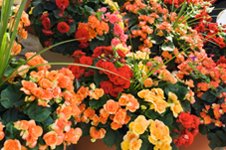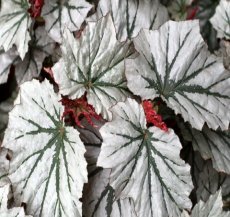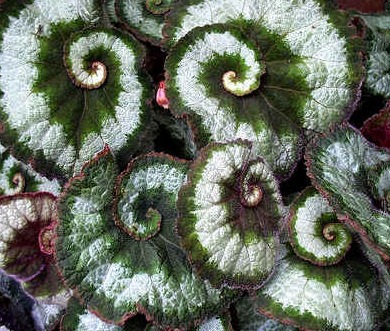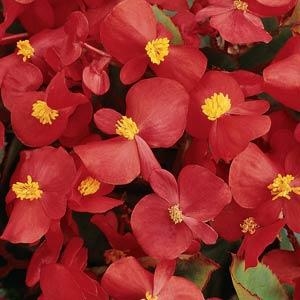Begonia Plants – Colorful Flowers, Attractive Foliage
All begonias have fleshy stems and uneven leaves – one half of the leaf is longer than the other. The shape of the leaves vary. Begonia leaves can be rounded with scalloped edges, elongated hearts, or ivy shaped forms.
Flowers are either male or female. Female flowers (a home for seedpods) last for weeks, while male blooms are usually short-lived.
Some begonia species that are grown outdoors can also be
 grown indoors for short
lengths of time – tuberous begonias (grown in hanging baskets), and wax
begonias.
grown indoors for short
lengths of time – tuberous begonias (grown in hanging baskets), and wax
begonias.Begonias that are ideal houseplants include Angel Wing begonias, Rex Begonias, and Rieger Begonias.
Popular Begonia Plants
Begonias vary in size and longevity, as well as leaf and flower shape. | Angel Wing Begonias are popular houseplants due their attractive leaves and colorful flowers. They are long-lived and can be propagated easily by rooting stem cuttings. |
 | Rex Begonias are harder to grow; however, their unique stained-glass leaves make a striking display. They produce large leaves that are marked with dramatic colors, such as pink, green, silver and burgundy. |
 | Reiger Begonias are used for short-lived color, commonly displayed on windowsills. When the flowers fade they can be propagated from rooted stem cuttings or discarded. The best time to purchase Rieger Begonias from the florist is early winter, when the flowers are on the brink of blooming. |
 | The Wax Begonia is known for its round, thick, waxy leaves – giving this colorful flowering plant its common name. They can be displayed in containers or hanging baskets. Wax Begonias can also be planted as a border or mass planting in the landscape. |
Basic Tips for Begonia Care
- Begonias are sensitive to changes in their environment. It is best to buy begonias from a local nursery. If the plant must be shipped, warm weather conditions are preferable.
- When you bring begonia plants home, protect them from drafts and dry conditions by enclosing them in a loose plastic bag for the first few days. Handling begonias with care in the first few weeks can improve longevity.
- Begonias can be propagated by setting stem tip cuttings to root in a warm, humid environment. Some species can be grown from seed; however, the easiest method is by rooting stem cuttings or leaves.
- To avoid problems with overwatering and root rot, do not plant begonias in larger containers.
- Begonias can suffer from over-watering, as well as extremely dry soil. A general rule of thumb is to allow the top inch of soil to become almost dry between watering; however, water requirements will vary by species.
- Begonias need moderate to dry humidity. You can place begonias on a tray of pebbles filled with water or place them near a humidifier.
Note: Begonia care requirements can vary, depending on the species. Be sure to review the requirements that are specific to your plant.
Additional Begonia Information
Begonia Plant Care - Basic Tips and InformationPlant Containers - Choosing the Right Containers for Your Plants and Flowers
Watering Plants - Tips and Techniques
Growing Begonias - Tips on How to Grow Begonia Plants





